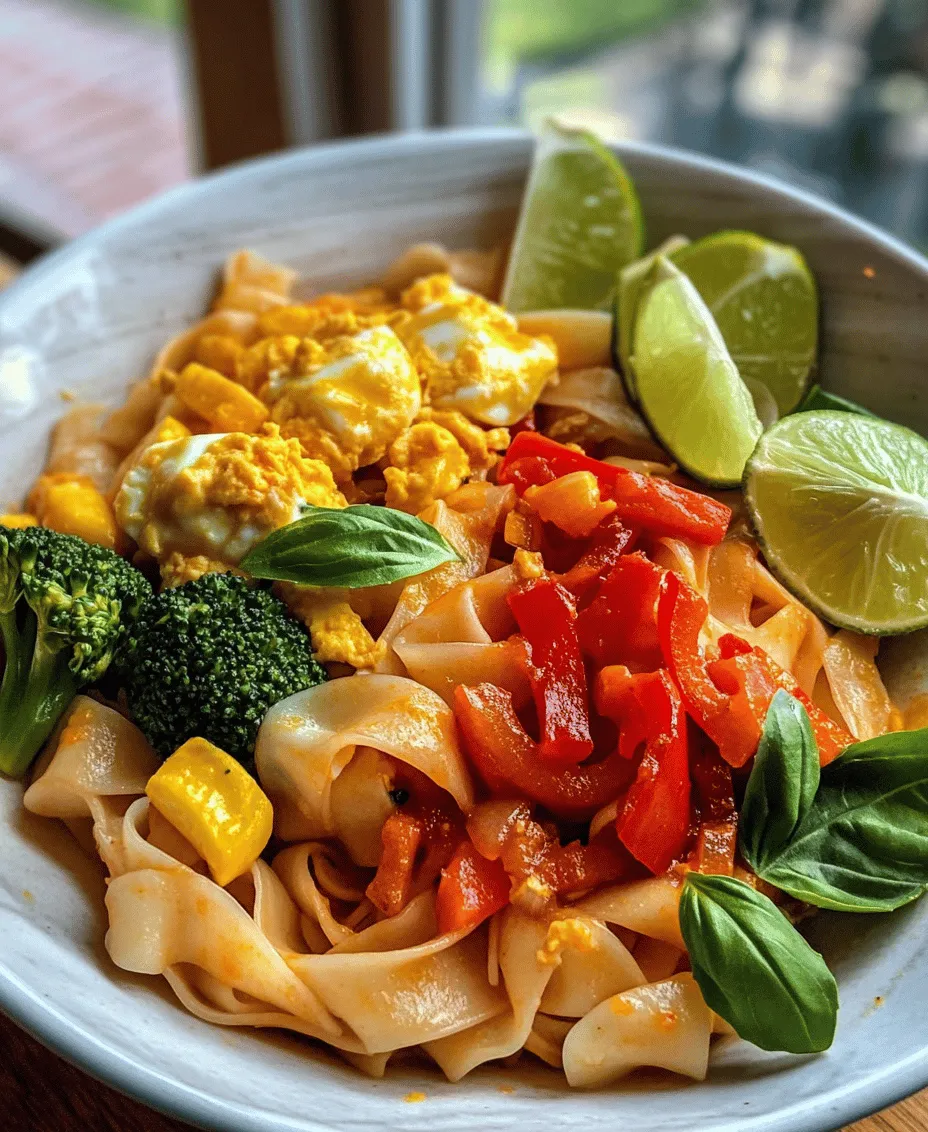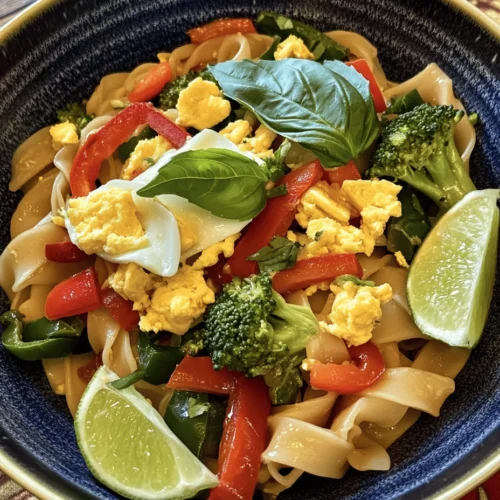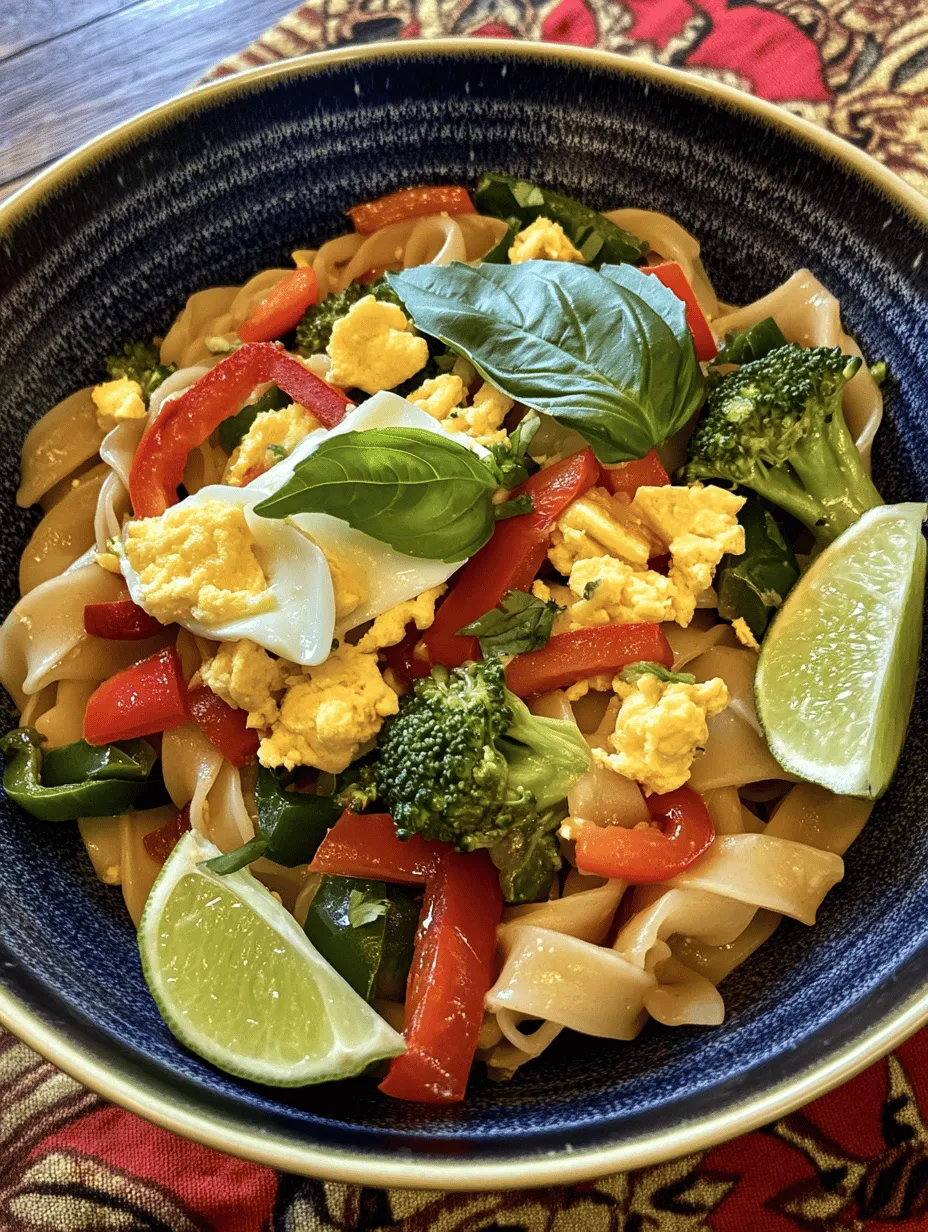Introduction
Drunken Noodles, known in Thailand as Pad Kee Mao, are a tantalizing dish that has captured the hearts and palates of food lovers around the globe. This iconic stir-fried noodle dish is a staple in Thai cuisine, celebrated for its bold flavors and comforting texture. The enticing combination of wide rice noodles, fresh vegetables, and a medley of sauces creates a culinary experience that is both satisfying and invigorating.
The dish derives its popularity from its unique ability to cater to a wide range of taste preferences. Whether you are a spice aficionado who craves the heat of chilies or someone seeking a cozy meal to enjoy after a long day, Drunken Noodles offer the perfect solution. Moreover, this recipe is incredibly versatile, allowing for various adaptations. Vegetarians can easily swap out meat for tofu or additional vegetables, making it a delightful option for everyone at the table.
As we embark on this flavorful journey, you will discover not only how to prepare Drunken Noodles but also the rich history and cultural significance that accompany this beloved dish.
Understanding Drunken Noodles
Origins and History
The origins of Drunken Noodles can be traced back to Thailand, where it is often enjoyed as a late-night street food option. The name “Pad Kee Mao” translates to “drunken stir-fried noodles,” and there are several theories behind this intriguing title. One popular belief is that the dish was originally intended to be a remedy for hangovers, combining bold flavors and hearty ingredients that would satisfy and rejuvenate.
While the exact origins remain somewhat murky, what is clear is that Drunken Noodles have become synonymous with Thai culinary culture. The dish reflects the vibrant and dynamic nature of Thai cuisine, known for balancing sweet, salty, sour, and spicy flavors. Over time, it has gained international recognition, gracing menus in Thai restaurants around the world and becoming a favorite among diners seeking an authentic taste of Thailand.
Traditional Ingredients and Flavors
At the heart of Drunken Noodles lies a harmonious blend of traditional ingredients that contribute to its distinctive taste. The main component, rice noodles, is essential for achieving the dish’s signature chewy texture. These noodles are typically wider than other varieties, allowing them to soak up the flavorful sauces and spices that define Drunken Noodles.
In addition to noodles, the dish features an array of fresh vegetables, including bell peppers, broccoli, and baby corn. These ingredients not only provide a burst of color but also enhance the dish’s nutritional profile. The use of fresh herbs, particularly basil, adds an aromatic quality that elevates the overall flavor experience.
The sauces and seasonings used in Drunken Noodles are equally vital. Soy sauce, oyster sauce, and fish sauce come together to create a well-rounded flavor profile that is sweet, salty, and slightly spicy. The balance of these components is what makes Drunken Noodles a beloved dish among those who appreciate the intricate flavors found in Thai cuisine.
The Name “Drunken Noodles”
The name “Drunken Noodles” has sparked curiosity among those unfamiliar with the dish. It is believed to reference the dish’s spiciness and its ideal pairing with beer. The heat from the chilies and the robust flavors of the sauces make it a perfect accompaniment to a cold beverage, enhancing the overall dining experience. Additionally, the dish’s rich flavors and comforting nature make it a popular choice for those enjoying a night out or seeking a satisfying meal after a long day.
Key Ingredients and Their Roles
To create the perfect Drunken Noodles, it’s essential to understand the key ingredients that contribute to the dish’s tantalizing flavors and textures. Here, we will explore each component in detail, highlighting their roles and importance.
Rice Noodles
Rice noodles are the foundation of Drunken Noodles, providing the necessary texture and structure. Typically, flat rice noodles are used, ranging from 1/4 inch to 1/2 inch in width. These noodles are known for their ability to absorb flavors, which is crucial for achieving the rich taste that defines the dish.
When preparing rice noodles, it’s important to soak them properly. Start by placing the dried noodles in hot water for about 30 minutes or until they are soft but still slightly firm. Drain and rinse them under cold water to prevent sticking. Properly cooked noodles ensure a delightful chewiness that complements the stir-fried ingredients beautifully.
Vegetable Oil and Garlic
Vegetable oil plays a vital role in stir-frying Drunken Noodles, as it allows for even cooking and helps achieve the desired smoky flavor. The high smoke point of vegetable oil makes it ideal for stir-frying at high temperatures, which is essential for a successful dish.
Garlic is another key ingredient in Thai cooking, providing a robust flavor that enhances the overall taste of Drunken Noodles. When sautéed, garlic releases its aromatic oils, infusing the dish with a savory depth. Using fresh garlic will yield the best results, as it adds a fragrant quality that perfectly complements the other ingredients.
Protein Choices: Chicken vs. Tofu
One of the great aspects of Drunken Noodles is the flexibility in protein choices. You can opt for chicken, tofu, shrimp, or even beef, allowing you to cater to different dietary preferences.
– Chicken: When using chicken, boneless, skinless thighs or breasts are ideal. They provide a tender and juicy texture, especially when marinated in soy sauce and other seasonings before cooking. To achieve the best results, slice the chicken thinly against the grain to ensure quick and even cooking.
– Tofu: For a vegetarian option, tofu is an excellent choice. Extra-firm tofu works best as it holds its shape during cooking. To enhance the flavor, consider marinating the tofu in soy sauce and allowing it to absorb the seasonings. Pan-frying the tofu until golden adds a delightful crispy texture that contrasts beautifully with the soft noodles.
Colorful Vegetables
A vibrant assortment of vegetables is essential for creating a visually appealing and nutritious dish. Common choices include bell peppers, broccoli, and baby corn, which not only add color but also contribute essential vitamins and minerals.
– Bell Peppers: These vegetables come in various colors, including red, yellow, and green, each bringing a unique sweetness and crunch. Slice them into thin strips to ensure they cook evenly and blend seamlessly with the noodles.
– Broccoli: Rich in vitamins C and K, broccoli adds a delightful crunch and nutritional boost. Cut the florets into bite-sized pieces to allow for quick cooking.
– Baby Corn: This tender vegetable provides a unique texture and sweetness to the dish. It cooks quickly, so add it to the stir-fry towards the end to retain its crispness.
Sauces and Seasonings
The magic of Drunken Noodles lies in its flavorful sauces and seasonings. A combination of soy sauce, oyster sauce, dark soy sauce, and fish sauce creates a complex flavor profile that is truly irresistible.
– Soy Sauce: A staple in Asian cooking, soy sauce adds a rich, savory umami flavor. It’s essential for marinating proteins and enhancing the overall taste of the dish.
– Oyster Sauce: This sauce lends a unique sweetness and depth of flavor that complements the other ingredients beautifully. It is often used in stir-fried dishes to create a glossy finish.
– Dark Soy Sauce: This thicker and sweeter variant of soy sauce adds a beautiful color and deep flavor to the dish. Use it sparingly to avoid overpowering the other flavors.
– Fish Sauce: A quintessential ingredient in Thai cuisine, fish sauce provides a salty and slightly funky flavor that elevates the dish’s overall taste. Use it judiciously, as its potent aroma can be overwhelming.
Achieving the right balance of sweet, salty, and spicy flavors is key to creating the perfect Drunken Noodles. Adjust the amount of each sauce based on your personal preference, and feel free to add more chilies for an extra kick.
Eggs and Basil
Eggs are often included in Drunken Noodles to add richness and depth to the dish. Scrambling an egg into the stir-fry creates a creamy texture that binds the noodles and ingredients together. For an authentic touch, use farm-fresh eggs to enhance the flavor.
Fresh basil is another crucial component of Drunken Noodles. Thai basil, with its distinct anise flavor, is the ideal choice, but sweet basil can also be used if Thai basil is unavailable. Adding a generous handful of fresh basil towards the end of cooking releases its aromatic oils, imparting a fragrant quality that elevates the entire dish.
Lime Wedges
Finally, lime wedges are often served alongside Drunken Noodles, adding a bright and zesty flavor that cuts through the richness of the dish. Squeezing fresh lime juice over the noodles just before serving enhances the overall taste and adds a refreshing element that balances the spiciness.
By understanding the key ingredients and their roles in Drunken Noodles, you are well-equipped to embark on your culinary adventure. In the next section, we will dive into the step-by-step instructions for creating this flavorful dish, ensuring that you can recreate this Thai favorite in your own kitchen.

The Significance of Acidity in Flavor Enhancement
Acidity plays a pivotal role in elevating the flavors of dishes, particularly in Thai cuisine, where balance is essential. In the Drunken Noodles Delight recipe, the inclusion of ingredients such as lime juice and fish sauce not only adds depth but also brightens the overall flavor profile. The sharpness of acidity helps to cut through the richness of the noodles and proteins, creating a harmonious blend of taste that excites the palate. When acidity is well-balanced with sweetness and spice, it enhances the dish’s complexity, making every bite a delightful experience.
Step-by-Step Instructions for Drunken Noodles Delight
Preparation of Ingredients
Before you begin cooking, it’s crucial to prepare all your ingredients. This ensures a smooth cooking process, especially since stir-frying requires quick movements. Here’s how to prepare:
1. Soaking Rice Noodles:
– Start by taking 8 ounces of flat rice noodles. Place them in a large bowl and cover them with hot water. Allow them to soak for about 20-30 minutes until they are pliable but not fully cooked. Drain and rinse the noodles with cold water to stop the cooking process and prevent them from sticking together.
2. Slicing Chicken and Vegetables:
– For optimal cooking, slice 1 pound of boneless chicken breast into thin strips against the grain. This ensures tenderness and faster cooking.
– Prepare your vegetables: thinly slice 1 bell pepper (any color), chop 1 cup of broccoli florets, and mince 3 cloves of garlic. You can also add other vegetables like carrots or snap peas based on your preference.
Stir-Frying Techniques
Stir-frying is a quick cooking method that requires high heat and fast movements. Here are tips to ensure you achieve the best results:
1. High Heat:
– Heat your wok or large skillet over high heat until it is smoking hot. Add 2 tablespoons of vegetable oil, swirling it around to coat the surface. The high temperature helps to sear the ingredients quickly, locking in moisture and flavor.
2. Cooking Order:
– Start by adding the chicken strips to the hot oil. Stir-fry for about 3-4 minutes until the chicken is browned and just cooked through. Remove the chicken from the pan and set it aside.
– In the same pan, add the minced garlic and stir-fry for about 30 seconds until fragrant. Then add the sliced bell pepper and broccoli, cooking for an additional 2-3 minutes. The goal is to maintain a slight crunch in the vegetables.
Combining Flavors
Once your proteins and vegetables are cooked, it’s time to bring everything together with flavor:
1. Coating the Noodles:
– Return the chicken to the pan and add the soaked rice noodles. Pour in the prepared sauce made from 3 tablespoons of soy sauce, 2 tablespoons of oyster sauce, and 1 tablespoon of lime juice. Use tongs or a spatula to toss everything together, ensuring the noodles are evenly coated. The key is to keep the noodles moving to avoid sticking and burning.
2. Adjusting Spice Levels:
– If you prefer a spicier dish, add crushed red pepper flakes or a dash of sriracha at this stage. Mix well and taste the dish, adjusting the spice according to your preference.
Nutritional Analysis of Drunken Noodles Delight
Understanding the nutritional content of your dish can help you make better dietary choices. Here’s a breakdown of the calories and macronutrients per serving of Drunken Noodles Delight:
– Calories: Approximately 450-500 calories
– Protein: 30 grams
– Carbohydrates: 60 grams
– Fat: 12 grams
Using fresh ingredients not only enhances flavor but also provides a wealth of nutrients. For instance, broccoli is rich in vitamins C and K, while bell peppers add a good dose of antioxidants. To make this dish healthier without sacrificing flavor, consider the following suggestions:
– Substitute traditional soy sauce with low-sodium soy sauce to reduce sodium intake.
– Use whole grain rice noodles for added fiber.
– Increase the vegetable content to boost the nutrient density of the meal.
Variations and Customizations
Drunken Noodles Delight is a versatile recipe that can be easily customized. Here are some variations to consider:
Vegetarian and Vegan Options
For those who prefer plant-based meals, you can replace the chicken with tofu or tempeh. Here’s how:
– Tofu: Use firm tofu, cut it into cubes, and pan-fry until golden brown before adding it to the dish.
– Tempeh: Slice tempeh into thin strips and stir-fry for a nutty flavor.
For the sauce, substitute oyster sauce with a mushroom-based sauce to keep the umami flavor intact while making it vegan.
Spice Level Adjustments
Adjusting the spice level can accommodate various palates:
– For a mild version, skip the red pepper flakes and focus on the savory notes of the sauce.
– For medium heat, include a tablespoon of chili paste or fresh sliced chilies.
– For those who love heat, try adding a tablespoon of sambal oelek or extra crushed red pepper flakes.
Additional Ingredients
Feel free to incorporate other vegetables or proteins based on personal preference or seasonal availability. Some ideas include:
– Add baby corn, snap peas, or zucchini for extra crunch and color.
– Experiment with proteins like shrimp, beef, or pork, adjusting the cooking time as needed.
Serving Suggestions
To truly enjoy Drunken Noodles Delight, consider these serving suggestions:
1. Ideal Pairings:
– This dish pairs wonderfully with a cold beer or a refreshing Thai iced tea. The richness of the noodles complements the lightness of these drinks.
2. Presentation Tips:
– Serve the noodles in a deep bowl, garnished with fresh basil leaves, sliced lime, and a sprinkle of crushed peanuts for added texture and flavor. The visual appeal of the dish enhances the dining experience.
3. Cultural Context:
– In Thailand, Drunken Noodles are often enjoyed as a late-night street food option. They embody the lively and vibrant nature of Thai cuisine, making them perfect for gatherings or casual dinners.
Conclusion
Preparing Drunken Noodles Delight is not just about cooking; it’s a culinary adventure that brings comfort and excitement to your dinner table. With its bold flavors and vibrant ingredients, this dish is sure to impress family and friends alike. The balance of acidity, spice, and savory elements creates a flavor explosion that will have you coming back for more.
As you explore this recipe, don’t hesitate to unleash your culinary creativity. Tailor the dish to suit your tastes, experiment with various ingredients, and enjoy the process of cooking. Whether you’re making it for a special occasion or a weeknight meal, Drunken Noodles Delight will undoubtedly become a beloved favorite in your culinary repertoire.



